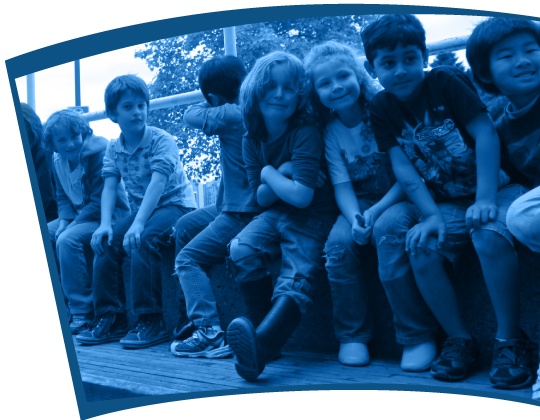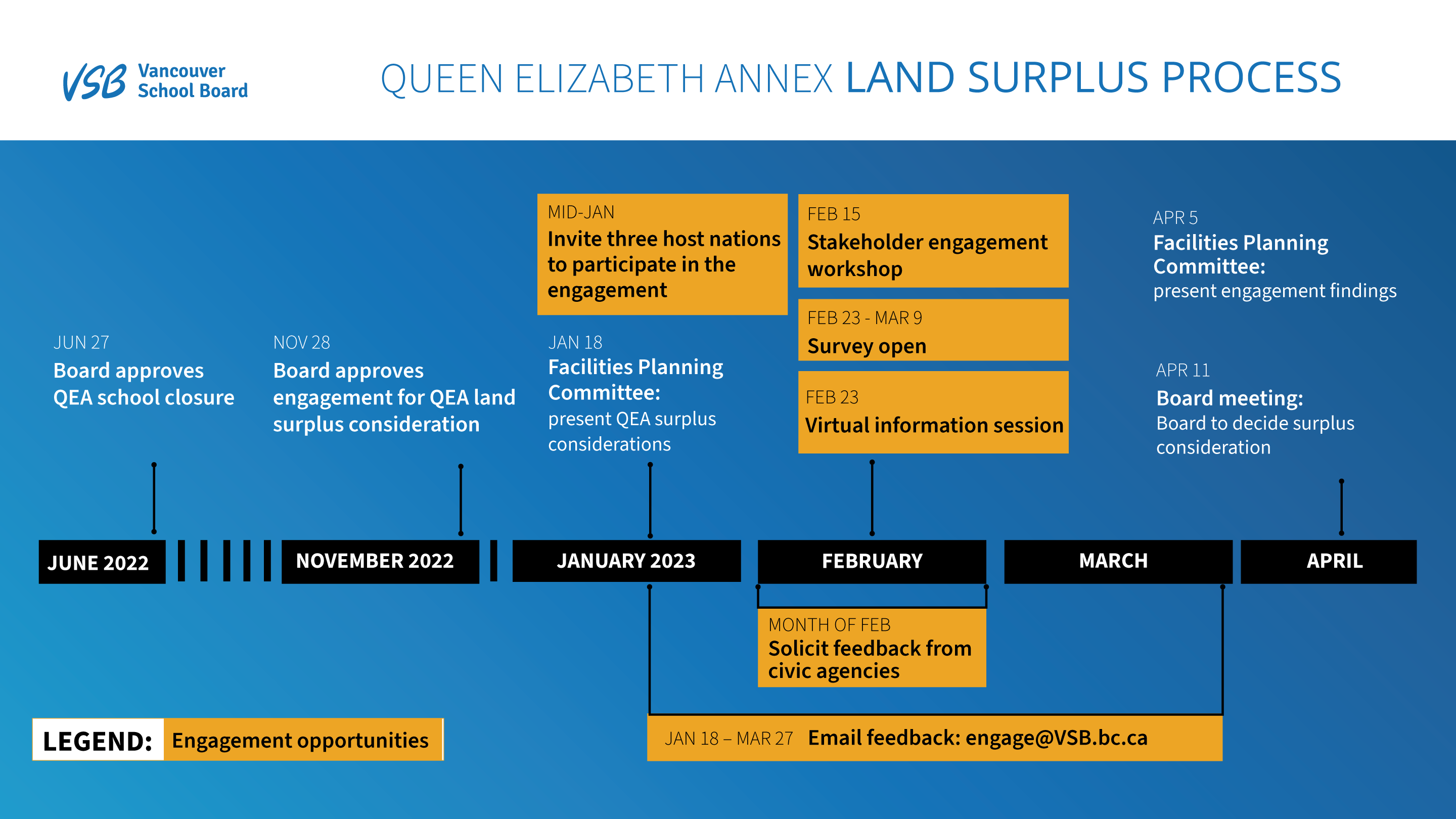Queen Elizabeth Annex Land Surplus Consideration
QEA Land Surplus Consideration
Following the June 2022 decision to close Queen Elizabeth Annex (QEA), the Board is now considering declaring the QEA site and its buildings surplus to the educational needs of the District. No decision has been made. The Board must first decide whether to surplus the land, before exploring alternative land use possibilities.
Selling or leasing VSB property is governed by the School Act through the Disposal of Land or Improvements Order and Board Policy 20 – Disposal of Land or Improvements “The Board has the responsibility for the disposal of its Real Property and may, after considering future educational needs and school space requirements for the school district, deem a property no longer required for further educational purposes or other Board purposes and determine to proceed to dispose of such property.”
District recommendation
As discussed during the consideration to close QEA and detailed in future development considerations, the site is not needed for educational purposes now, or into the future.
In addition, the Francophone public school board, Conseil scolaire francophone de la Colombie-Britannique (CSF), is interested in acquiring the QEA site. Given this, future development considerations, and that CSF is another public education Board, the District recommends the Board declare QEA as surplus to District needs and proceed with disposition of the site and buildings to CSF. Visit alternate community use for further information.
Potential funds generated from a sale or long-term lease of the land would provide capital revenue for the Board, that can then be directed for priority capital investment such as building a new school in an area with enrolment demand, as well as expanding or seismically upgrading an existing school.
Engagement opportunities
As per Policy 20, the Board has directed the District to engage with stakeholders, local governments, community organizations and/or the public, prior to determining future land use.
The District will begin engaging with stakeholders, the xʷməθkʷəy̓əm (Musqueam), Sḵwxwú7mesh (Squamish) and səlilwətaɬ (Tsleil‐Waututh) Nations, the school communities and neighbourhood associations in the vicinity of QEA, other civic agencies, as well as the public during the month of February, 2023. Visit engagement process for further information.
Next steps
Feedback from the engagement, along with the District staff’s recommendation to surplus the site will help inform the Board’s decision at the public Board meeting, scheduled on April 11, 2023.
If the Board declares the QEA site and its buildings as surplus, it may then instruct staff to proceed with the land disposition process, which includes either sale or long-term lease of the land.
Engagement Findings
On April 5, 2023 the What We Heard - Engagement Findings Report, which included findings from an online survey, community information sessions, stakeholder and Rightsholder engagement sessions was presented to the Facilities and Planning Committee.
Engagement Process
The District implements the best practices for engagement by the International Association of Public Participation (IAP2) standards spectrum under AP 106 – District Public Engagement.
The engagement goal is to provide an opportunity for all parties to share feedback regarding the surplus consideration and possible disposition of the QEA site for the Board’s consideration.
Also outlined in Policy 20, the engagement process must include:
- Consideration of future enrolment growth in the school District, including K-12, adult programs, and early learning
- Consideration of alternative community use of surplus space in school buildings and other facilities
- Fair consideration of community input, and adequate opportunity for the community to respond to the Board’s plan for the Real Property
Engagement opportunities
As per Policy 20, prior to determining future land use, the District must engage with key community members. In the month of February, the District will engage with the following groups:
- January: reached out to the xʷməθkʷəy̓əm (Musqueam), Sḵwxwú7mesh (Squamish) and səlilwətaɬ (Tsleil‐Waututh) Nations to seek their input and feedback.
- February 15: stakeholder engagement workshop where attendees were provided a discussion guide to review beforehand.
- February 23 – March 9: 10-minute survey, available
- March 8: virtual information session for school communities and neighbourhood associations in the vicinity of QEA
- February 23: virtual information session for school communities and neighbourhood associations in the vicinity of QEA
- School communities include Queen Elizabeth Annex, Queen Elizabeth Elementary, Jules Quesnel Elementary, Kitchener Elementary, Queen Mary Elementary, Norma Rose Point Elementary, University Hill Elementary, University Hill Secondary and Byng Secondary.
- Neighbourhood associations include Dunbar, West Point Grey, UBC and Arbutus Ridge areas.
- See the recorded session from February 23:
- February 23 – March 9: survey open to all groups, including the public
- February 15 – March 27: engage@vsb.bc.ca open to receive public feedback. Emails received will be forward to the Board in its entirety.
- Month of February: reach out to other civic agencies such as the City of Vancouver to seek their feedback
- March 8: additional virtual information session for school communities and neighbourhood associations in the vicinity of QEA
- April 5: special delegation meeting added for the Board to specifically hear about the QEA land surplus declaration consideration from the public
Within each engagement activity, participants will have an opportunity to respond to the proposal to surplus the QEA site in order to help inform the Board’s decision.
A report summarizing the engagement results will be shared with the Board, in advance of the April 11, 2023 Board meeting. Feedback received, along with the staff’s recommendation will help inform the Board’s decision about the proposed surplus declaration of the QEA site.
QEA School Information
QEA Educational Programming
Queen Elizabeth Annex (QEA) accommodates students in the District Choice Early French Immersion (EFI) Program. QEA is the annex to Ecole Jules Quesnel (JQ). After completing Grade 3, students from QEA move to JQ to complete their EFI program.
Over the past several years, QEA has accommodated about 70 kindergarten to Grade 3 students.
As a District choice program, QEA is not a catchment school and is not needed to accommodate catchment enrolment. Instead, students in the area are accommodated at other nearby schools.
On June 6, 2022, at a special Board meeting, the Vancouver School Board approved the closure of Queen Elizabeth Annex (QEA) effective June 30, 2023.
QEA Site Information
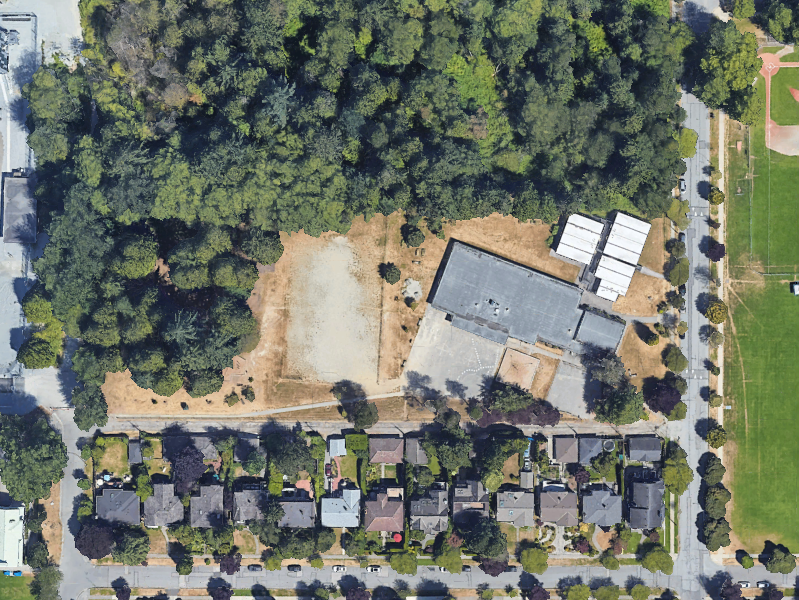
Address: 4755 Crown Street, Vancouver
Site Area: 1.54ha
Building age: 59 years (built in 1964)
Number of classrooms: 5 classrooms, 1 resource room, 1 library and 1 activity room
Number of portables: 7 (including 2 coded as washroom portables)
Operating capacity: 98
Seismic rating: High seismic risk (category 3)
2023 BC property assessed value: $46,359,000
Future Enrolment Growth
This section considers future enrolment growth from a District perspective, and a localized (QEA) perspective.
District Enrolment Considerations
Despite an overall increase in Vancouver’s population, both the birth rate and the number of school-aged children continue to decline in the city, resulting in a 26-year history of generally declining enrolment at the VSB. Although there is growth of school-aged children in certain high-density areas such as Olympic Village, the North Cambie Corridor, and Downtown core, this is offset by the declining number of school aged children in other areas in Vancouver. Several factors contribute to the enrolment decline including an ageing population, reduced birth rate, and housing unaffordability resulting in more families with school aged children moving out of the city.
Enrolment History
The chart below illustrates the trend of declining enrolment in relation to overall population growth in the District. Since 1997, the population in the City of Vancouver and UBC/UEL areas has increased by about 160,000 whereas in the same period VSB enrolment has declined by close to 9,000 students. In 10 years, by 2032, the area is expected to have an increase of around 84,000 residents whereas VSB is forecast to have approximately 43,000 students, a decrease of nearly 5,000 students from 2022 numbers.
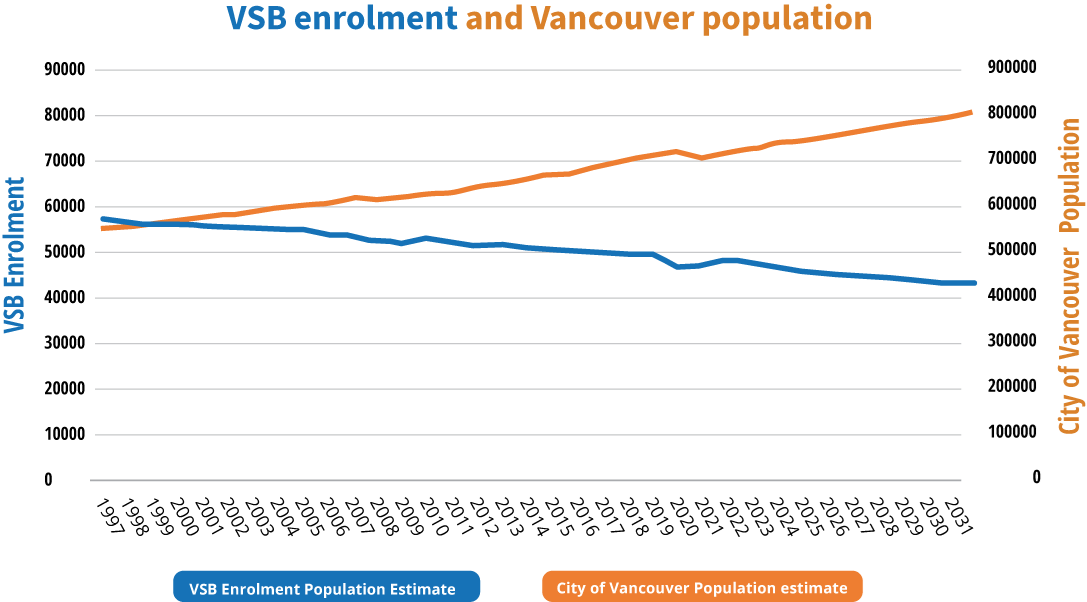
Enrolment Forecast
The total District operating capacity for K-12 schools is 57,398* spaces. The District’s enrolment peaked in 1997 with close to 57,000 kindergarten to Grade 12 students. As of September 30, 2022, enrolment for the 2022-23 school year was 48,580 students, meaning that today, there are about 9800 surplus spaces available to accommodate future unanticipated enrolment growth. Additionally, a new school at Coal Harbour is expected to open in 2024, increasing the District’s operating capacity further. As the graph illustrates below, the impact of development and increasing population has not offset the decline in school aged children (5-17 years old), and hence the decline in enrolment.
*Excludes Carleton Elementary and Garibaldi Annex, neither of which accommodate students.
QEA Enrolment Considerations
To assess the potential future impacts and District needs for the QEA site, a thorough study of the enrolment and demographic trends near QEA was analyzed. The study area included elementary schools at QEA, JQ, Bayview, Carnarvon, Lord Kitchener, Norma Rose Point, Queen Elizabeth, Queen Mary, Southlands and University Hill elementary.
With the exception of Norma Rose Point*, enrolment in these areas has been declining for many years mirroring the decline in birth rate and youth population.
*Further explanation about this enrolment trend is explained here.
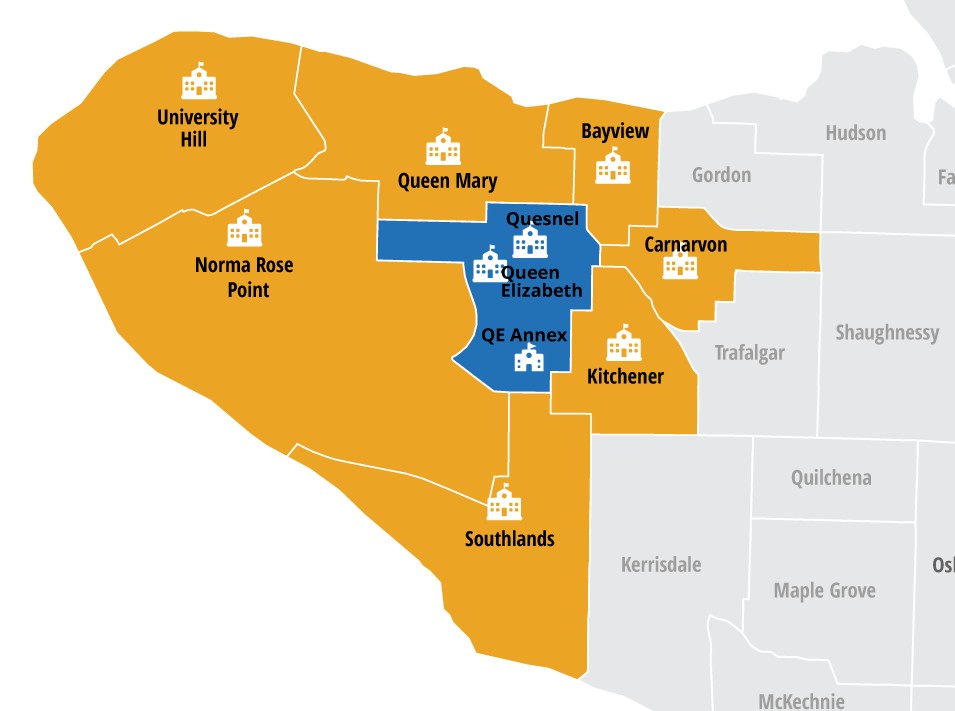
Enrolment History
The QEA study area is comprised of the two elementary schools at UBC/UEL and six elementary schools on the west side of Vancouver Over the last decade, the overall number of students enrolled within the study area increased by 95 students or three per cent; however, the increase was almost entirely due to enrolment growth at Norma Rose Point Elementary which opened in 2014. Enrolment at the schools in the study area located in Vancouver declined by 20 per cent and enrolment at University Hill Elementary declined by 19 per cent. During the same period, the number of children in that area aged 1 to 4 years declined by 32 per cent and the number of children in the 5 to 12 age group decreased by 17 per cent.
It is important to acknowledge that between 2020-2021 enrolment numbers were lower than expected as a result of the Covid-19 pandemic and its restrictions to enter the country. As a result, when restrictions were completely lifted in 2022, the District saw a higher than expected number of new or returning Canadian families registering for VSB. That said, even with the influx of new students in 2022, enrolment in schools near QEA is still below the 2019 levels, prior to the pandemic. The current 2022 enrolment levels still align with pre-pandemic trends for this group of schools, which is on the decline.
The chart below illustrates the trend of declining enrolment in relation to overall youth population decline in the study area.
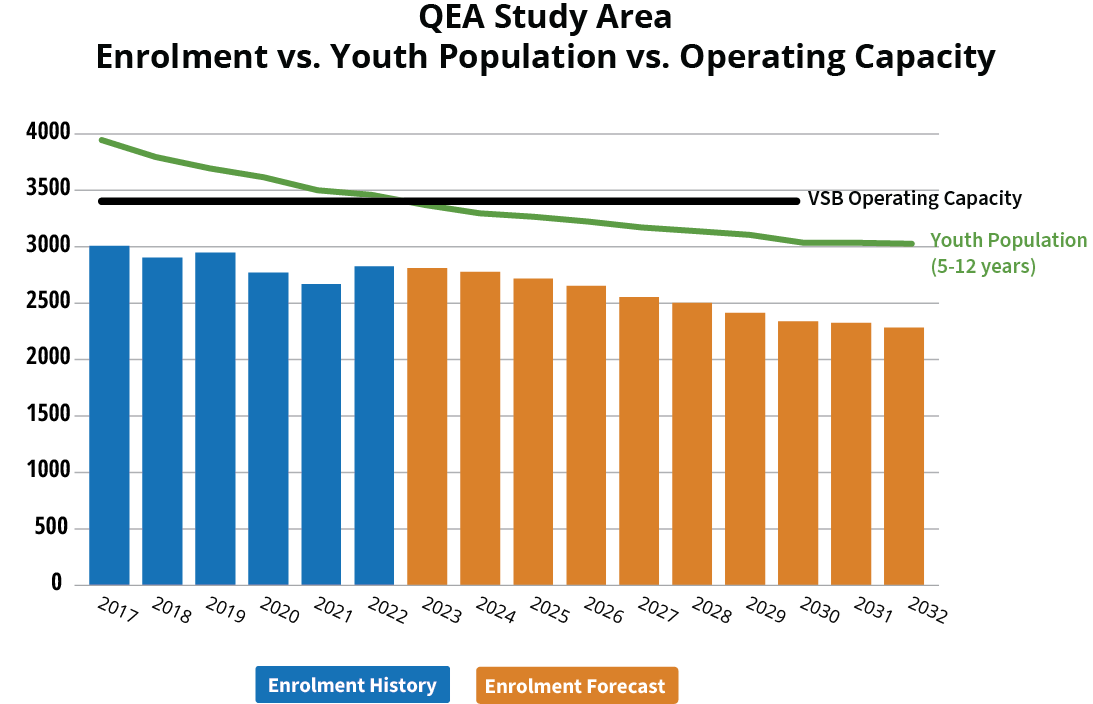
Enrolment forecast
As illustrated by the graph above, at present there is no indication that there will be sustained or substantial enrolment growth in the vicinity of the QEA site. In fact, the area has experienced overall enrolment decline since 2016. There is surplus capacity at many surrounding schools, a total of 583 spaces currently available. Forecasts indicate there could be more than 900 surplus spaces 10 years from now.
If enrolment growth does materialize, the annex building on the QEA site does not have the minimal capacity to accommodate the increase with a small operating capacity of only 98 spaces. That means, the District would likely not use the annex building to accommodate students, as it would be limited by its capacity. If there was an unexpected increase in school-age children in the area, there is sufficient overall school capacity in the existing nearby elementary schools to accommodate any potential future enrolment growth.
Additionally, the current QEA building is not seismically safe, meaning it does not advance the District’s long range planning objectives of accommodating students in modern, safe, healthy schools located in their catchment. As such, the District would not consider building, nor would the government consider funding, a new school on the QEA site as there are several other options to accommodate enrolment growth more effectively and cost efficiently available at UBC and on the west side of Vancouver.
Future Development Considerations
The VSB plans for the long-term use of facilities through the capital planning process. Similar to the City of Vancouver UBC/UEL’s capital planning process, the District’s capital plan considers future long-term needs much longer than the 10-15 year forecasts for enrolment trends. The capital planning process emphasizes flexibility and adaptability in facilities to ensure District buildings will be in use for decades to come.
Developments in the District
The District works with the City of Vancouver and UBC/UEL to ensure there are sites available to build new schools in areas of potential enrolment growth due to new development. New or expanded schools are typically funded by the Ministry of Education and Child Care. As a result of this long-term planning, the District is well positioned to foresee, adapt, and respond to increases in the youth population from any development in future decades.
Current schools
- University Hill Secondary, Elsie Roy Elementary and Crosstown Elementary are examples of schools that had land previously set aside or acquired by the VSB years in advance to accommodate potential enrolment growth as part of the capital planning process.
- A new school at Coal Harbour is in construction. The school will address enrolment pressure in the downtown area. The school is being fully funded by the VSB using proceeds from the sale of subterranean land rights to BC Hydro to build a new Westend substation.
Future schools
The sites below have been identified for future schools when government funding becomes available.
- Olympic Village: the District has finalized a long term lease agreement with the City of Vancouver for the school site at Olympic Village. The school is in the planning phase.
- Wesbrook: the site at UBC is available to accommodate a new elementary school.
- East Fraser Lands - the site in the River District is available to address potential enrolment pressures in nearby catchments. It is important to note recent developments in the River District have not yet translated into large increases in the number of school-aged students enrolling in the District.
Developments near QEA
The District works collaboratively and in partnership with the City of Vancouver on many planning projects to closely monitor the city’s major developments. Future areas of development, such as University of British Columbia (UBC)/University Endowment Lands (UEL) and Jericho Lands, were also studied by staff in making the recommendation to surplus the QEA site. The District is well positioned to foresee, adapt and respond to increases in the youth population from any development in future decades.
Accommodating Enrolment Growth at UBC/UEL
Both elementary schools (Norma Rose Point and University Hill Elementary) in the University of British Columbia (UBC)/ University Endowment Lands (UEL) area are full, with some students being placed at nearby schools in the District. Enrolment is increasing due to ongoing development of new residential units in area. To date enrolment forecasts have adequately captured the impact of continuing development. These forecasts indicate that there will be additional enrolment pressure in the area in coming years; however rapid enrolment growth is not anticipated.
There is significant available space at schools near UBC/UEL (Queen Mary, Queen Elizabeth, Southlands, Kitchener and Bayview) to accommodate elementary students who are not able to be enrolled in their catchment school (Norma Rose Point Elementary and University Hill Elementary).
In addition, the Wesbrook site near University Hill Secondary school has been set aside for the construction of a new elementary school as required when capital funding becomes available. A new elementary school at UBC is prioritized in Year 5 of the Capital Plan.
Accommodating Enrolment Growth from the Jericho Lands Development
Led by the City of Vancouver, the Jericho Lands Planning Program is still in the early phases of planning and information about how many additional residents the development will yield in the area is still being determined. The project is expected to be developed over the next 30 years. That said, District staff is planning collaboratively with CoV staff with the objective that the development plan for the Jericho Lands will include land zoned for elementary school use – this is the optimal solution to ensure the development of a complete low carbon family-oriented community with co-located amenities. Prior to the construction of a school on the Jericho lands, the District has existing options to accommodate students, that require no capital investment, such as using surplus capacity at nearby schools including Queen Mary, Bayview, Queen Elizabeth and Kitchener. In addition, if necessary, there is also temporary accommodation available at the Queen Elizabeth site to accommodate potential students from the future Jericho lands development.
The District does not foresee any circumstance where the QEA site (with an operating capacity of 98 maximum students) would be used or needed to accommodate students from the Jericho Lands development. As funding becomes available from the government, the District will pursue seismic upgrades and, if necessary, expansions at Southlands, Queen Elizabeth Elementary and Carnarvon. Each of these school sites is larger and more suitably located for a catchment school than the QEA site.
Alternate Community Use
As per the School Act, through the Disposal of Land or Improvements Order, all school boards can only dispose of land through a sale or long-term lease to a community agency or organization for alterative community use, pending ministerial approval. School boards do not need additional ministerial approval if the land is sold or leased long-term to another school board or independent school.
As discussed during the QEA closure, if the Board decides to surplus the QEA site, District staff is recommending the Board dispose of the site to the Francophone public school board, Conseil scolaire francophone de la Colombie-Britannique (CSF), either through sale or long-term lease.
Why CSF?
Disposing the land, either through sale or long-term lease to CSF would provide capital revenue for the Board, that can then be directed to Board priorities for capital investments such as building a new school in an area with enrolment demand, expanding or seismically upgrading an existing school.
There is serious interest from CSF to acquire the QEA site. CSF has filed a civil claim which names the District, the Province of B.C. and the Ministry of Education. The claim mentions a 2016 B.C. Supreme court ruling requiring the Province to supply a school site in Vancouver west of Granville Street, to CSF. In addition, there is a separate, confidential education mediation underway involving the CSF, the District and Ministry of Education to resolve a land dispute. These two separate proceedings are requiring extensive and costly District resources.
Furthermore, in April 2022 legislative amendments made to the School Act give the Province the ability to transfer land held by a board to CSF. This power will only be used when all other avenues to fulfil the Province’s obligations to minority language education rights-holders have been exhausted.
Given the forementioned legal proceedings, CSF’s interest in the site and that CSF is another public education Board, the Superintendent recommends the Board declare QEA as surplus to District needs and proceed with disposition of the site to CSF.
Other Considerations
As per Policy 20, the District also analyzed the surplus impacts to adult education and early learning.
Adult Education
Enrolment in VSB Adult Educational Programming has declined during the past decade in alignment with the overall provincial trend. The VSB has two adult learning centers that are centrally located to provide convenient access to adult learners. In consideration of its location, the QEA site will not be required to accommodate adult programs in the future.
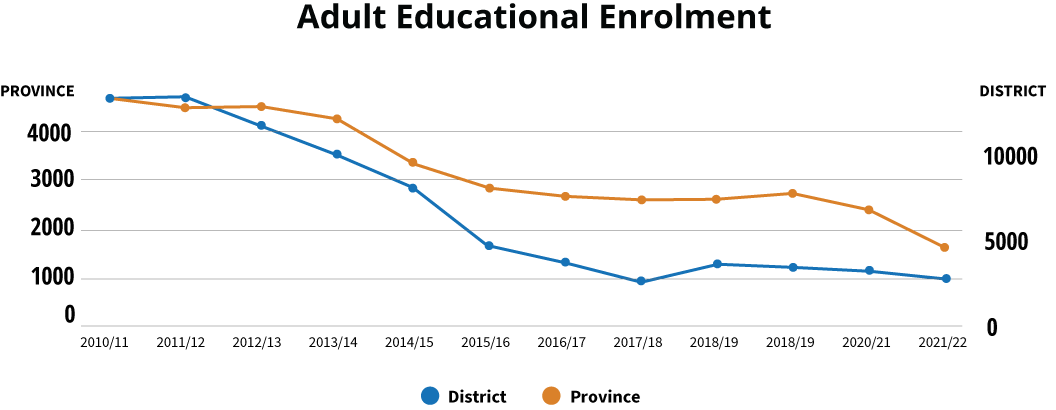
Early Learning
VSB offers early learning through its StrongStart program. Funded by the Ministry of Education and Child Care, StrongStart is a free drop-in program for preschool children, ages zero to five years old. StrongStart provides a rich learning environment, designed for early learning development. Qualified early childhood educators lead learning activities where children find opportunities to make friends and interact with others of similar ages. The overall learning experience is shared as parents and caregivers attend with their children and are encouraged to get involved in activities like telling stories, playing games and serving healthy snacks.
There are 19 StrongStart programs operating in elementary schools across Vancouver. Currently the Ministry of Education and Child Care is not funding new Strong Start programs. If funding becomes available, the program will not be offered at QEA as the District would place the program in a school with a larger community hub.
Updates
The District is committed to remaining open and transparent along every step of the land surplus consideration and engagement process. Once information becomes available, we will directly share it with the impacted school communities and the District's stakeholder groups.
The following updates have been shared with the community:
January 13 - Letter sent to three host Nations: xʷməθkʷəy̓əm (Musqueam) Band, Sḵwx̱wú7mesh Úxwumixw (Squamish) Nation and səlilwətaɬ (Tsleil-Watuth) Nation inviting them to participate in the engagement process
January 13 - Letter sent to QEA school community re: the Board’s decision to begin public engagement
February 14 - Letter to impacted school community and neighbourhood associations near QEA (the community) re: engagement opportunities
February 15 - Letter sent to civic agencies re: feedback about the Board’s surplus consideration
February 24 - Reminder letter to the community re: engagement opportunities
March 1 - Letter to the community re: virtual information session added
March 10 - Letter to the community re: special delegation added
April 5 - Engagement Summary Report presented at the Facilities Planning Committee

